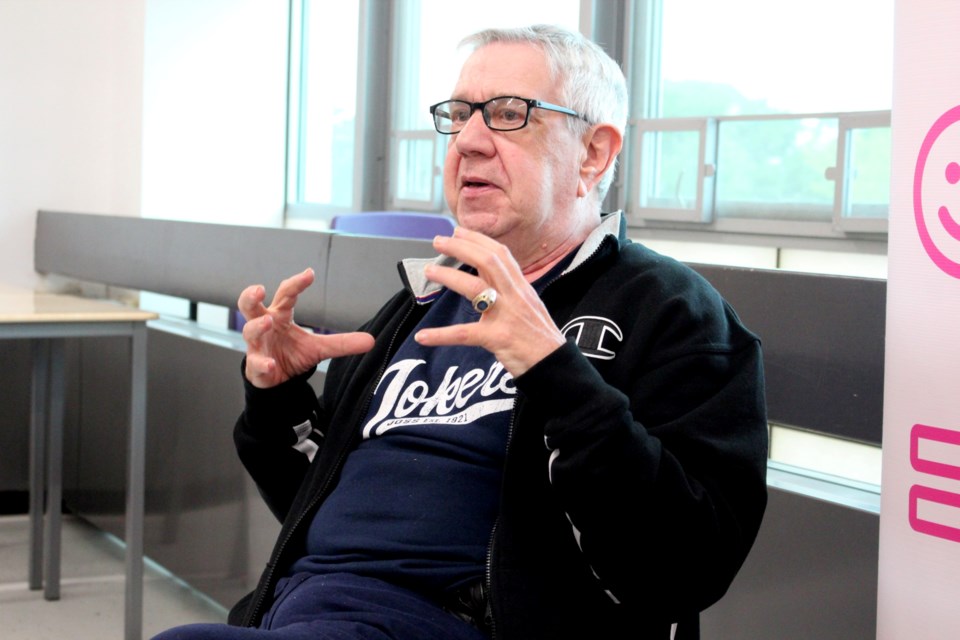A participant in the 1969 Stonewall Uprising in New York City gave local students a first-hand look at a pivotal moment in gay history this week.
Activist Martin Boyce was invited to take part in the Rainbow District School Board’s Embrace Diversity: Free to Be Me symposium.
On May 19, the 74-year-old Boyce participated in an “Oprah style” interview at Lo-Ellen Park Secondary School conducted by Jeremy Dias from the International Day of Pink organization.
The Stonewall Uprising was a series of spontaneous demonstrations by members of the gay community in response to a police raid that began in the early morning hours of June 28, 1969, at the Stonewall Inn in the Greenwich Village neighbourhood of New York City.
The uprising is widely considered the most important event leading to the gay liberation movement and the modern fight for LGBTQ+ rights in the United States.
Boyce explained the atmosphere in New York City in 1969, when members of the LGBTQ+ community found some freedom to be who they were on their “turf” of Manhattan’s Greenwich Village.
But he said they also faced constant police harassment.
“It was a very, very powerful world that still had the police pressing on us,” he said. “The police wanted us in jail, the psychiatrists wanted us in medical institutions, and the clergy wanted us in hell.”
He said the police would even send out officers dressed as gay men to try to trick members of the community into outing themselves. But Boyce said they could be found out because they never changed their shoes.
In terms of the Stonewall Uprising on June 28, 1969, Boyce said he was out on the town that night, when he heard about a police raid at the nearby the Stonewall Inn in Greenwich VIllage. Police paddy wagons were parked several doors down.
Boyce said that if you didn’t happen to be involved in a police raid, you watched them, “because that was the way we victimized ourselves.”
“I heard about police brutality, I knew about police brutality, but I had never witnessed that kind of brutality,” he said.
Boyce recalled a “Latina Queen” fighting back against the police, and how she was pushed into a paddy wagon, but not before she kicked the officer with a silver, high-heeled shoe.
He said that was the “first hint that this night was going to be like no other night in gay history in New York.”
Eventually, the tactical police force was called in “armed to the teeth.” Boyce said this unit had been trained to deal with the Black Panthers and paramilitary groups.
However, those participating in the uprising had the advantage of knowing the neighbourhood.
“We knew the village,” said Boyce, who added he was never arrested himself. “They were so sure of themselves, and they couldn't understand what happened, because they couldn’t corner us, corral us. That was the whole point.”
Realizing the tactical police unit wanted to shut down the riots as quickly as possible, participants sought to prolong what was happening. Boyce said he and others formed a Rockettes-style kick line in front of police.
By dawn, the whole city knew what was happening. Boyce said Stonewall was the crack that began the winning over of hearts and minds, and a slow change to people’s attitudes.
A year after the Stonewall Uprising on June 28, 1970, the first gay pride marches took place in several major American cities, including New York, to mark the anniversary.
Boyce also provided his recollection of New York’s first gay pride march. He said he was planning to stay in the middle of the crowd, as he’d be less likely to be harassed. But when he got there, there were only 18 or 20 people.
But he said there was a “minority of support” from people in the street. Many people, including “gays” watching from the sidelines, eventually joined in, said Boyce.
By the time the event reached Central Park, “there were so many of us, it was incredible,” he said. He recalled one marcher doing a “dance of freedom” from the top of a hill.
Boyce said at the time, gay society in New York was stratified, as those with money wouldn’t associate with more marginized gay people.
But at that moment, he realized gay people “were now a people.”
“That is my most favourite moment of gay history,” he said.
The Rainbow board’s two-day Free to be Me symposium is aimed at creating and enhancing school-based supports for students who are lesbian, gay, transgender, bisexual, questioning and two-spirited (LGTBQ2S) as well as students with friends and family members in these communities.
Since its inception in 2009, Embrace Diversity: Free to Be Me has expanded to include poverty, race, culture and disabilities.
After his talk, Boyce took questions from the students. One asked how he felt when he could actually be himself out in public.
He said “great,” but added that this has happened “little by little.” Boyce said most of his family members were always supportive of his identity, especially his father, a New York City cab driver.
But in response to a question from a student who asked if he’s proud of the way society treats the LGBTQ+ community now, Boyce said he’s ready for the next battle.
He said the U.S. seems to want to extend rights to some members of the queer community, and throw others, such as trans people, under the bus.
“We’re not going to do that,” Boyce said. “We’re not going to throw them under the bus. What’s the point?”
Heidi Ulrichsen is the associate content editor at Sudbury.com. She also covers education and the arts scene.
